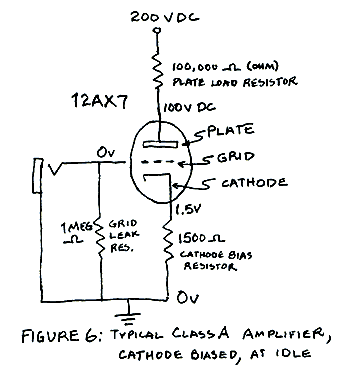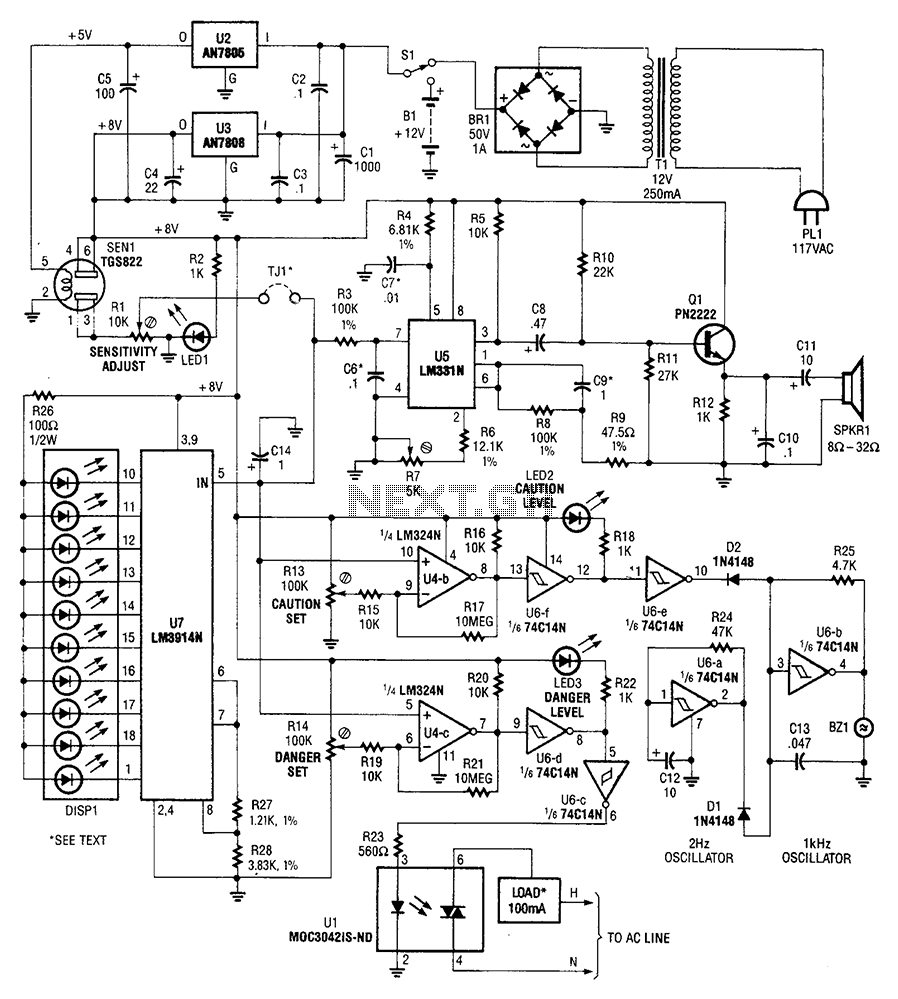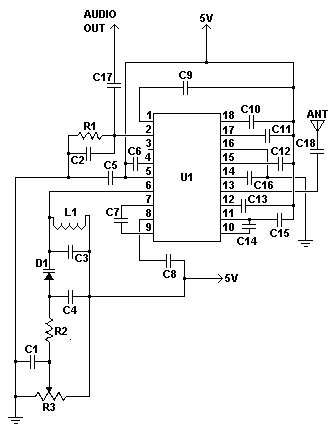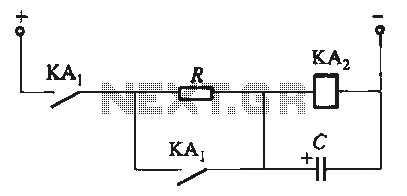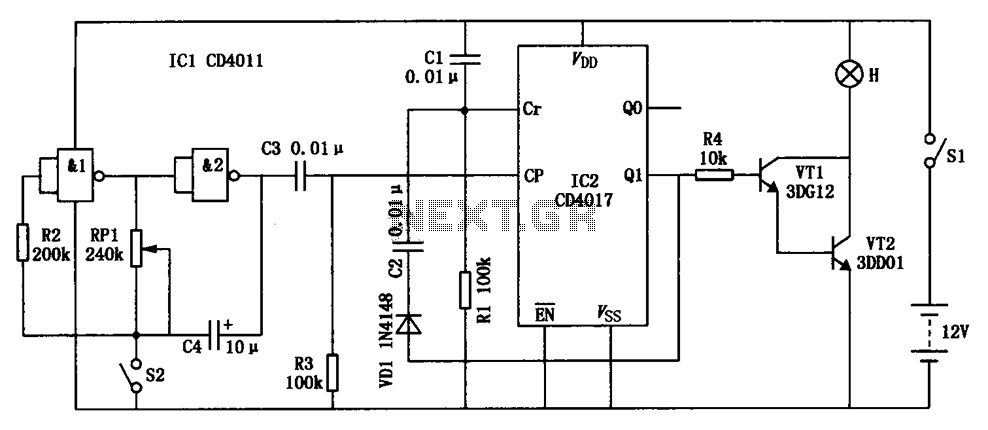
Car Alarm and Immobilizer circuit
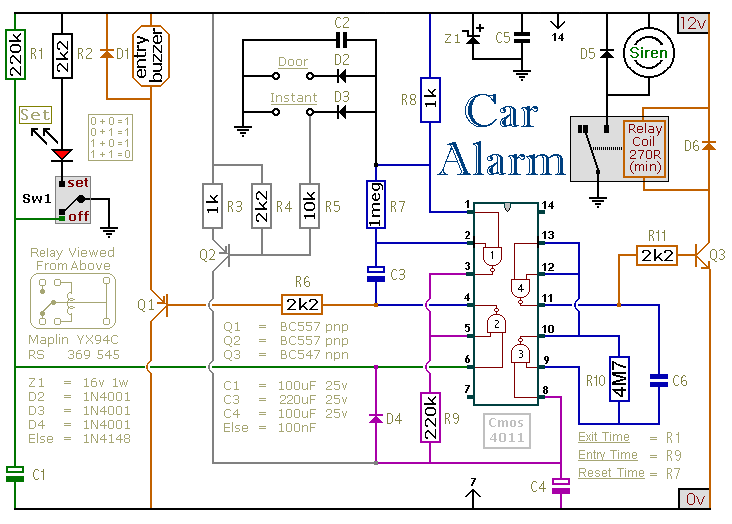
This circuit is designed to secure a vehicle at a low cost if constructed independently, making it more affordable than purchasing a commercial car alarm system. The alarm is activated by opening switch Sw1, which can be any small 1-amp single-pole change-over switch, or for enhanced security, a key-switch may be used. Once Sw1 is opened, there is a grace period of approximately 10 to 15 seconds to exit the vehicle and close the door. When the door is reopened, a buzzer will sound to indicate the alarm is active. The user then has another 10 to 15 seconds to turn Sw1 to the off position. If this action is not taken, the siren will activate. The siren output is designed to be intermittent, switching on and off, with the frequency determined by capacitor C6 and resistor R10. As long as any trigger switch remains closed, the siren will continue to sound. The circuit will automatically reset about 2 to 3 minutes after all switches have been opened.
This vehicle security circuit employs a straightforward design that effectively deters unauthorized access. The primary components include a switch (Sw1), a buzzer, a siren, a capacitor (C6), and a resistor (R10). The switch serves as the main control element, allowing the user to activate the alarm system upon exiting the vehicle.
The use of a single-pole change-over switch provides flexibility in the design, enabling the user to choose between a standard switch and a more secure key-switch option. This choice enhances the overall security of the system, as it requires a key to deactivate the alarm, making unauthorized access more challenging.
The timing mechanism, governed by the capacitor and resistor, is crucial for the functionality of the alarm. The values of C6 and R10 can be adjusted to modify the on/off cycle of the siren, allowing customization based on user preference or specific environmental conditions. This feature ensures that the alarm can be tailored to the user's needs, whether they prefer a rapid siren response or a more prolonged alert.
The buzzer provides an initial warning when the vehicle door is opened after the alarm has been set, alerting the user to the active security status. This feature serves as a deterrent to potential intruders and allows the vehicle owner a brief window to deactivate the alarm before the siren engages.
The circuit's reset functionality is a vital aspect of its design. By resetting approximately 2 to 3 minutes after all switches are opened, the system conserves power and prevents unnecessary siren activation in the event of accidental triggering. This automatic reset ensures that the alarm system remains effective over time without requiring manual intervention.
Overall, this vehicle security circuit offers an economical and customizable solution for enhancing automotive security, leveraging simple electronic components to create a reliable alarm system.This circuit is designed to secure your car, of course with little cost if you build it yourself. Much cheaper than buying a car alarm device that is already on the market. The alarm is set by opening Sw1. It can be any small 1-amp single-pole change-over switch for added security you could use a key-switch. Once Sw1 is opened you have about 10 to 15 seconds to get out of the vehicle and close the door behind you. When you return and open the door the buzzer will sound. You have 10 to 15 seconds to move Sw1 to the off position. If you fail to do so, the siren will sound. The output to the siren is intermittent it switches on and off. The speed at which it switches on and off is set by C6 and R10. While any trigger-switch remains closed, the siren will continue to sound. About 2 to 3 minutes after all of the switches have been opened, the circuit will reset. 🔗 External reference
This vehicle security circuit employs a straightforward design that effectively deters unauthorized access. The primary components include a switch (Sw1), a buzzer, a siren, a capacitor (C6), and a resistor (R10). The switch serves as the main control element, allowing the user to activate the alarm system upon exiting the vehicle.
The use of a single-pole change-over switch provides flexibility in the design, enabling the user to choose between a standard switch and a more secure key-switch option. This choice enhances the overall security of the system, as it requires a key to deactivate the alarm, making unauthorized access more challenging.
The timing mechanism, governed by the capacitor and resistor, is crucial for the functionality of the alarm. The values of C6 and R10 can be adjusted to modify the on/off cycle of the siren, allowing customization based on user preference or specific environmental conditions. This feature ensures that the alarm can be tailored to the user's needs, whether they prefer a rapid siren response or a more prolonged alert.
The buzzer provides an initial warning when the vehicle door is opened after the alarm has been set, alerting the user to the active security status. This feature serves as a deterrent to potential intruders and allows the vehicle owner a brief window to deactivate the alarm before the siren engages.
The circuit's reset functionality is a vital aspect of its design. By resetting approximately 2 to 3 minutes after all switches are opened, the system conserves power and prevents unnecessary siren activation in the event of accidental triggering. This automatic reset ensures that the alarm system remains effective over time without requiring manual intervention.
Overall, this vehicle security circuit offers an economical and customizable solution for enhancing automotive security, leveraging simple electronic components to create a reliable alarm system.This circuit is designed to secure your car, of course with little cost if you build it yourself. Much cheaper than buying a car alarm device that is already on the market. The alarm is set by opening Sw1. It can be any small 1-amp single-pole change-over switch for added security you could use a key-switch. Once Sw1 is opened you have about 10 to 15 seconds to get out of the vehicle and close the door behind you. When you return and open the door the buzzer will sound. You have 10 to 15 seconds to move Sw1 to the off position. If you fail to do so, the siren will sound. The output to the siren is intermittent it switches on and off. The speed at which it switches on and off is set by C6 and R10. While any trigger-switch remains closed, the siren will continue to sound. About 2 to 3 minutes after all of the switches have been opened, the circuit will reset. 🔗 External reference
Warning: include(partials/cookie-banner.php): Failed to open stream: Permission denied in /var/www/html/nextgr/view-circuit.php on line 713
Warning: include(): Failed opening 'partials/cookie-banner.php' for inclusion (include_path='.:/usr/share/php') in /var/www/html/nextgr/view-circuit.php on line 713
